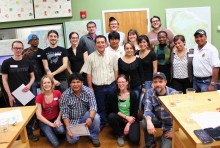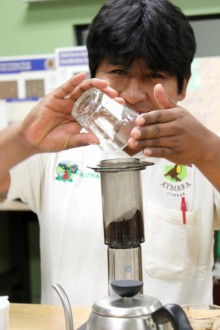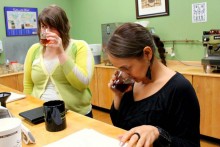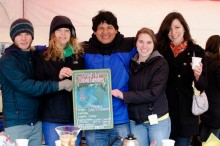
Over the years we have worked with cuppers from around the world as a tool to find and secure delicious coffee. Last year while a group of us were at a Specialty Coffee Association of America gathering about the future of the small farmer co-op movement, we looked around and realized that there were no baristas in attendance. Was it the language barrier? A cultural barrier? Or was it simply… a barrier? We wondered, how can we better connect baristas and coffee shop owners, the folks who sell and represent the delicious coffee we work so hard to lay hands on, with coffee cuppers, the people that work so hard to get us these tasty little beans? The result: Cooperation in Quality 2013.
We have hosted nearly 10 Cooperation in Quality seminars, some as far away as Bolivia with 19 cuppers participating, and others taking place in our own Quality Control lab with only two cuppers. Each training experience is different, but the general idea is that we present quality information and protocols to the cuppers. We introduce them to our U.S. coffee-consuming culture and exchange ideas. Our activities usually focus on our work in the laboratory, but this year we decided to invite six seasoned cuppers to Equal Exchange for a scientific and hands-on approach to coffee preparation, while connecting these cuppers to U.S. baristas and connecting both of them to the end consumer. It was a deep and meaningful week.
Step 1: Calibrate and Learn to Manual Brew
The six cuppers journeyed from Peru, Colombia and Uganda to spend the week with us in the quality laboratory. It was a unique opportunity for these cuppers to come together with our own Purchasing and Quality Control teams, and we spent the first couple of days just calibrating our palettes: cupping coffee, tasting chocolate and getting to know each other. These calibration sessions help the cuppers better understand what we are looking for as specialty coffee buyers and why. We then took their experience a step further by introducing the cuppers to new and traditional brewing technology and show them how many people in the U.S. brew their coffee on a daily basis. Why? Because at the end of the day, we all need to know what coffee drinkers want.

In my regular travels to coffee-growing countries, farmers and cuppers always ask, “What does my coffee taste like? What does the consumer want in a cup of coffee?” Great questions. Knowing that the coffee cuppers primarily taste their coffee through cupping, we wanted to expose them to a different way of preparing coffee called manual brewing - small batch brewing that requires attention to detail, with each device delivering a different flavor profile. Our training included traditional methods like the French Press and newer methods such as the Clever and AeroPress. We wanted to teach the cuppers about the science and methodology for each method and provide them with the space to experiment with the coffee from their cooperative, using these various methods.
Although manual brewing is practiced worldwide, the widespread phenomenon is still young in its delivery and larger understanding, so this provided a beautiful platform to ignite creativity, collaboration and experimentation. I had the pleasure of choosing the coffees that we used for our week of calibration and assigned each cupper their coffee to work with; their job was to take the coffee and find the best manual preparation to represent that coffee. It was both challenging and very exciting to see how they proceeded throughout the week.
Step 2: Connect Cuppers with Baristas
Over the course of three days, each cupper worked to find the perfect brewing method for their coffee. As preferences formed in each of the cuppers’ minds, our fourth day was spent working with local baristas,coffee shop owners and Equal Exchange staff to further exchange ideas about the best way to prepare their individual coffees. We divided into small groups to help each cupper identify the best presentation of their coffee.

Step 3: Serve Coffee to the Public
One of our goals for Cooperation in Quality 2013 was to hand out free coffee to the public before the Specialty Coffee Conference in Boston. We asked the cuppers: if Equal Exchange could provide you with the knowledge about manual brewing, provide you with a space to practice, introduced you to the baristas that serve your coffee, do you think that you could then give away samples to the public on the Greenway outside of South Station? One by one, they said yes, and the concept of connecting cupper to barista expanded to the final link in the chain: coffee drinkers. On a very chilly and rainy morning, together we set up tents, hooked up water boilers, and gave away cups of manually brewed coffee. All of the cuppers got to engage the visitors to the tent, prepare their coffee and make the connection firsthand.
This will forever be our goal: to provide a link from producer to consumer. In this scenario it was taking path with the cupper - the person that knows the characteristics we as coffee buyers look for, empowered to go direct to the consumer and speak about how their coffee should taste.

Angelica Cordoba Arroyave of the ASPROCAFE Ingruma co-opin Caldas, Colombia, an Equal Exchange partner for more than 15 years, participated in Cooperation in Quality in 2011, and was here for the second time and was very enthusiastic about the experience. “I always learn very positive things from [Equal Exchange],” she told me. “Preparing coffee with different equipment was something I didn’t know very well; I had never had the experience to prepare my coffee differently and it became clear to me that not just cupping, but that preparing coffee [this way] is also a ritual, where the consumer sees and learns to value the work of the coffee producer, and that the supply chain works to bring these coffee drinks to the table … I am very proud of my coffee and thankful for the opportunity to learn and connect with the consumer.”
I wondered what each of the cuppers would do with this experience and new knowledge when they went back to their co-operatives. We sent each home with two of the manual brewing devices, and many of the cuppers told me they were excited to teach others about how to make coffee using them, particularly the coffee farmers that none of this could happen without.
MEET THE CUPPERS & THEIR BREW METHODS
- Lydia from Gumutindo in Uganda: chose the Clever, to highlight the blackberry flavors
- Henry from COCLA in Peru: chose the French Press to accentuate the thick body and chocolate notes
- Angelica from Asprocafe Ingruma in Colombia: chose the Chemex to bring out the lush grapefruit notes.
- Rodolfo from CEPICAFE in Peru: chose the Chemex because it brings out the coffee's floral fragrance, creamy body, bright acidity.
- Tibed & David from CECOVASA in Peru: chose the Clever for the bright acidity, distinct fruit and chocolate flavor.
